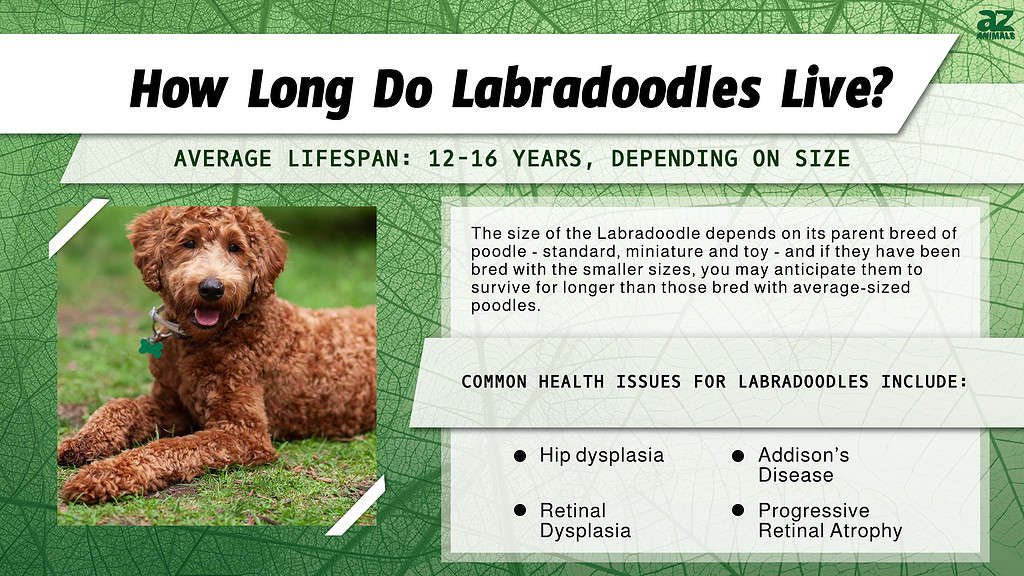
Labradoodles are one of the cutest puppy hybrids that you could own. They are a hybrid between a Poodle and a Labrador retriever, and they look just like big teddy bears. These dogs are excellent family companions since they are often cheerful and easy to train. They also like the companionship of others, including both humans and dogs. These cute, fluffy “doodle” dog varieties have only been around since 1988, even though they appear to have been around for quite some time.
So, what should you be aware of when it comes to Labradoodles? Let’s explore the labradoodle lifespan and all the ways you can help keep your pet labradoodle happy and healthy for a very long time!
How Long Do Labradoodles Live?

A Labradoodle can live for 12-16 years if it does not suffer from any exceptional health problems or accidents.
©Unknown/Shutterstock.com
The average lifespan of a labradoodle is 12-16 years, depending on its size. Labrador retrievers and standard poodles both have an average lifespan of 12 years. So, if you have a typical Labradoodle, which is a mix of these two breeds, you can usually expect them to live for roughly 12 years.
Miniature and toy poodles frequently live longer lives, as do tiny dogs in general. If the Labradoodle is crossed with one of these smaller breeds, you may anticipate them to survive for longer than those bred with average-sized poodles. While these projections are based on the average lifetime of their parent pups, some research shows that crossbred dogs roughly live a year or two longer than their parents as well. This is how their life expectancy has averaged out at 12-16 years.
Because Labradoodles are a relatively new breed, we don’t have many records on the longest-living one. However, a dog named Bella was a Labrador mix, much like a Labradoodle, and she lived to the age of 29.
With a better understanding of the labradoodle lifespan, let’s explore how they grow from puppies to adults!
The Average Labradoodle Life Cycle
You should expect your Labradoodle to go through four major life stages: puppyhood, adolescence, adulthood, and seniorhood.
Puppies
For the first five months of their lives, Labradoodles are usually classified as puppies. However, because they are developing so fast at this time, they will go through a variety of puppy phases. They will develop and become more interested in bonding with others during their puppy stage.
It is best to begin training a Labradoodle puppy between the ages of 10 and 16 weeks when they are aware and interested enough to understand what is going on and absorb what they are being taught. At this point, you can also begin exposing the puppy to new people and situations. This will help the puppy to develop good social skills.
Adolescence
This stage usually lasts from five or six months to about two years of age. They will start to get into more trouble during this stage as they’d have much more energy and would be going through growth spurts. They also become bored easily, and when they aren’t napping, they prefer to be quite active. Around this age, they also shed their clumsiness and become more coordinated. Labradoodles, in particular, will begin to demonstrate considerable skill and strength at this age.
Adulthood
Depending on the breed, you may anticipate your Labradoodle to reach maturity between the ages of two and three. At this point, it will be completely developed and stop growing bigger. Your dog will reach its physical and mental apex at this time since it’ll be considerably calmer and more relaxed.
Senior
When your Labradoodle reaches the age of nine or ten, it is considered a senior and will likely require additional care and attention. It may begin to slow down and have less energy than when it was younger. As with all dog breeds, it will also be predisposed to certain health issues as well.
What Factors Impact the Labradoodle Lifespan?

Hip dysplasia is frequent in Labradoodles and can result in arthritis.
©iStock.com/LSOphoto
Several health issues can shorten the life of a Labradoodle. Some of these may be avoided by breeding healthy dogs so that inherited disorders are not passed along. Others can be avoided or at least addressed with frequent check-ups and assistance from your veterinarian.
Some of these health issues include:
- Hip dysplasia: Hip dysplasia is frequent in big dog breeds like Labradoodles and can result in arthritis or the inability to walk. While not fatal in and of itself, severe forms of hip dysplasia can cause extreme pain and a loss of quality of life.
- Eye problems: Labradoodles are susceptible to a variety of eye problems, including cataracts, progressive retinal atrophy, and retinal dysplasia. Loss of eyesight isn’t necessarily harmful on its own. However, if your dog does not detect a threat in time, it’s more likely to be involved in an accident.
- Addison’s Disease: Addison’s disease occurs when the adrenal glands of a dog fail to generate adequate cortisol. if left untreated, it can cause renal damage and possibly death.
How to Extend the Life of Your Pet Labradoodle

In order to extend the life of your Labradoodle, make sure to take it for walks.
©Angeline Dobber/Shutterstock.com
Labradoodles are a charming and highly intelligent dog breed. This is why they continue to be a popular family dog breed. If you properly care for your Labradoodle, it will live a long and happy life.
These are the best tips to extend your labradoodle’s lifespan:
- Exercise your dog: Labradoodles love going out for walks and high-energy activities. They are great to jog and powerwalk with. All of these types of activities will keep the dog stimulated and help it burn off excess energy. If you don’t give your dog enough exercise, he may be more prone to vent his frustrations in other ways. This includes destructive behavior such as chewing, barking, or digging.
- Feed your dog a healthy diet: The normal adult Labradoodle diet needs to consist of a protein content of 18%, 5% fat, complex carbs, fatty acids omega-3 and omega-6, and vitamins, minerals, and antioxidants. Avoid dog food with artificial preservatives, grains, and high amounts of sugar.
- Regular vet check-ups: Taking your labradoodle to the vet on a regular basis can ensure that this dog enjoys a long and healthy life. A veterinarian can tell whether a Labradoodle has any health issues from a young age. The chance of a dog living a long and healthy life is severely reduced if any problem goes unnoticed and untreated. A dog should be examined by a veterinarian at least once a year.
The photo featured at the top of this post is © Lynxs Photography/Shutterstock.com
Ready to discover the top 10 cutest dog breeds in the entire world?
How about the fastest dogs, the largest dogs and those that are -- quite frankly -- just the kindest dogs on the planet? Each day, AZ Animals sends out lists just like this to our thousands of email subscribers. And the best part? It's FREE. Join today by entering your email below.
Thank you for reading! Have some feedback for us? Contact the AZ Animals editorial team.






